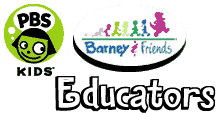|

Table Manners
Suggested Grade Level: Preschool-K
Based on: Barney & Friends #703: "Tea-riffic Manners!"
Objectives:
Although learning to be polite may not be easy for children, it is an
important lesson for young children to learn. Even the youngest child
can learn to say "please" and "thank you." Good manners are best learned
through modeling and everyday play activities between friends.
The children will:
- learn to say "please"
- know when to say "thank
you"
Skills:
- Pretend play
- Social/Emotional development
Materials:
- Paper plates, cups,
utensils, napkins
- Classroom table, housekeeping
center, or school cafeteria
Directions:
To help teach children appropriate table manners, pretend to visit a
very fancy restaurant.
Invite children to sit at a table (this may work best in the housekeeping
center, art tables or the school cafeteria). Have children help set
the table with plates, glasses, forks, spoons and napkins. Show children
the correct way to set the table with napkins and forks on the left
and spoons on the right of the plate.
When everyone is seated, show children how to place their napkins in
their laps and how to wipe their mouths. Practice asking politely for
items to be passed (using "please" and "thank you").
Talk about other table manners such as:
- not talking with food
in your mouth
- taking small bites of
food
- using forks and spoons
- chewing carefully
Extension:
Write "thank you" notes.
Children will understand the importance of saying "thank you" when they
are encouraged to write "thank you" notes. Help them write a note to
a school helper (cafeteria worker, janitor, nurse, secretary), a community
helper (firefighter, police officer, mail carrier), or a parent or relative.
Throughout the year, encourage "thank you" notes either individually
or as a group project for class visitors or parent helpers.
Barney
& Friends Home | PBS Kids Home
| Music | Games
| Coloring | Storytime
Parents & Educators | TV
Times
|









